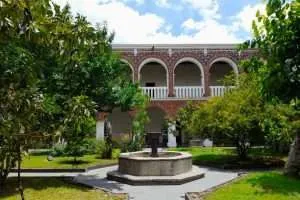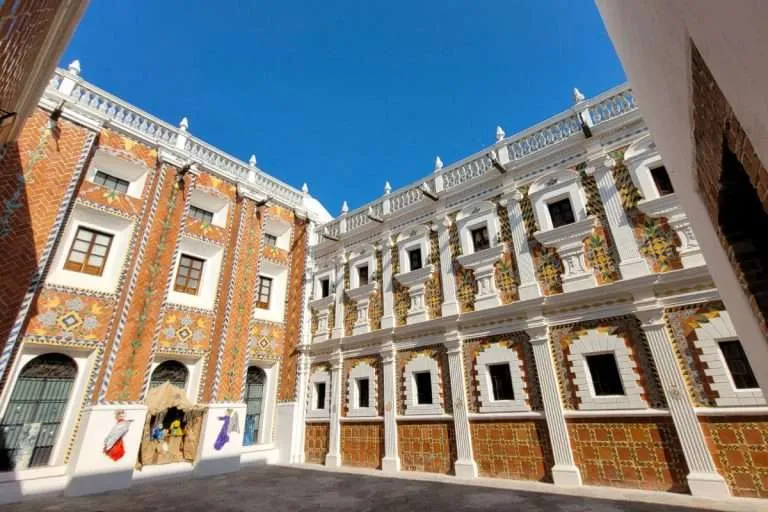
Marvel at the splendor of its elegant colonial buildings, streets and flavors that live up to its nickname "City Of the Angels".
A legend is responsible for this beautiful city being known as Puebla de los Angeles.

The Patio de los Azulejos is a historic building in the city of Puebla. It is a building that dates back to 1793, when its construction began as an addition to the Cloister of the "Venerable Concordia de San Felipe Neri", reason why it is also known as "La Casa de los ejercicios de San Felipe Neri" (The House of the exercises of San Felipe Neri).
The building was an initiative of Father Cayetano Medina and since then it has been used for religious, social, cultural and educational purposes.
Its decoration combines stone, brick and tile mosaic plasterwork in yellow, white, blue and green tones that form floral motifs. This decoration can be seen reflected especially in the wall panels.
In this place there was a printing press where lottery tickets were made and resources were obtained. In this place the Plan de Iguala was printed in 1816, where the emancipation of New Spain was proclaimed.
The Patio de los Azulejos was later the cradle of one of the first newspapers created in the state of Puebla, which was baptized with the name "La Abeja Poblana".
During the Reform War, in 1856, the Concordia Temple was one of the most affected buildings, however, the Patio de los Azulejos was not damaged. It was there where a story was generated that over the years became the Legend of the Patio de los Azulejos.
According to legend, after the Reform Laws, like many of the religious houses, it functioned as a neighborhood.
In one of the rooms on the second floor of the house lived an old lawyer.
Every night when he arrived he always found an old man sitting at the foot of the stairs, praying with a rosary in his hands.
Because of the habit of seeing each other every night and exchanging greetings, the lawyer and the mysterious man had a friendly relationship that led them to get to know each other better and engage in long conversations in the almost uninhabited neighborhood; between these conversations, the lawyer learned that his friend was a priest.
Time went by in this way, until one day two nuns came to the neighborhood to ask for alms. On their way they met the lawyer, who in the middle of the conversation told them that in that neighborhood lived a priest, whom they might know.
The two nuns looked at each other in amazement, since they had no reference to it. They asked him for the name of the priest; upon hearing it, neither could hide her astonishment. Immediately, the lawyer asked them again if they knew him and they told him the story of the old convent, of which they had heard that a priest appeared praying in that neighborhood every night.
Upon realizing that his friend was a spirit haunting the neighborhood, the lawyer could not stand the shock and moved house before investigating further about the mysterious man, the legend states.
There is a clear baroque style with mannerist motifs and classical elements.
The facades do not maintain a formal continuity with the intention of avoiding monotony. The spaces for common use (chapel, refectory) are distinguished from the spaces for personal reflection such as the cells in the eastern and southern bays.
With ornamental elements such as moldings, moldings, balustrades, balustrades, fleurons and pilasters with fluted shafts topped with Doric capitals on the first floor and Ionic on the upper floor; made with mixed material and covered with mortar, which creates strong contrasts in the facades, while illuminating the space.
The buttresses are decorated with brick and petatillo tiles.
The colors of the tiles are predominantly yellow ochre, which alludes to gold and thus to divinity; blue and blue with white, which refers to the Virgin Mary, and green to the plants of paradise.
Address: Av 11 Pte 110, Centro histórico de Puebla, 72000 Puebla, Pue.
More Official Info: Visit Puebla
Marvel at the splendor of its elegant colonial buildings, streets and flavors that live up to its nickname "City Of the Angels".
A legend is responsible for this beautiful city being known as Puebla de los Angeles.
The country is a land of contrasts. It has it all: a rich history and culture, a warm and pleasant climate, a varied geography, an impressive nature, a tasteful gastronomy and a friendly and helpful population ... in short: Mexico can fulfill all your wishes!